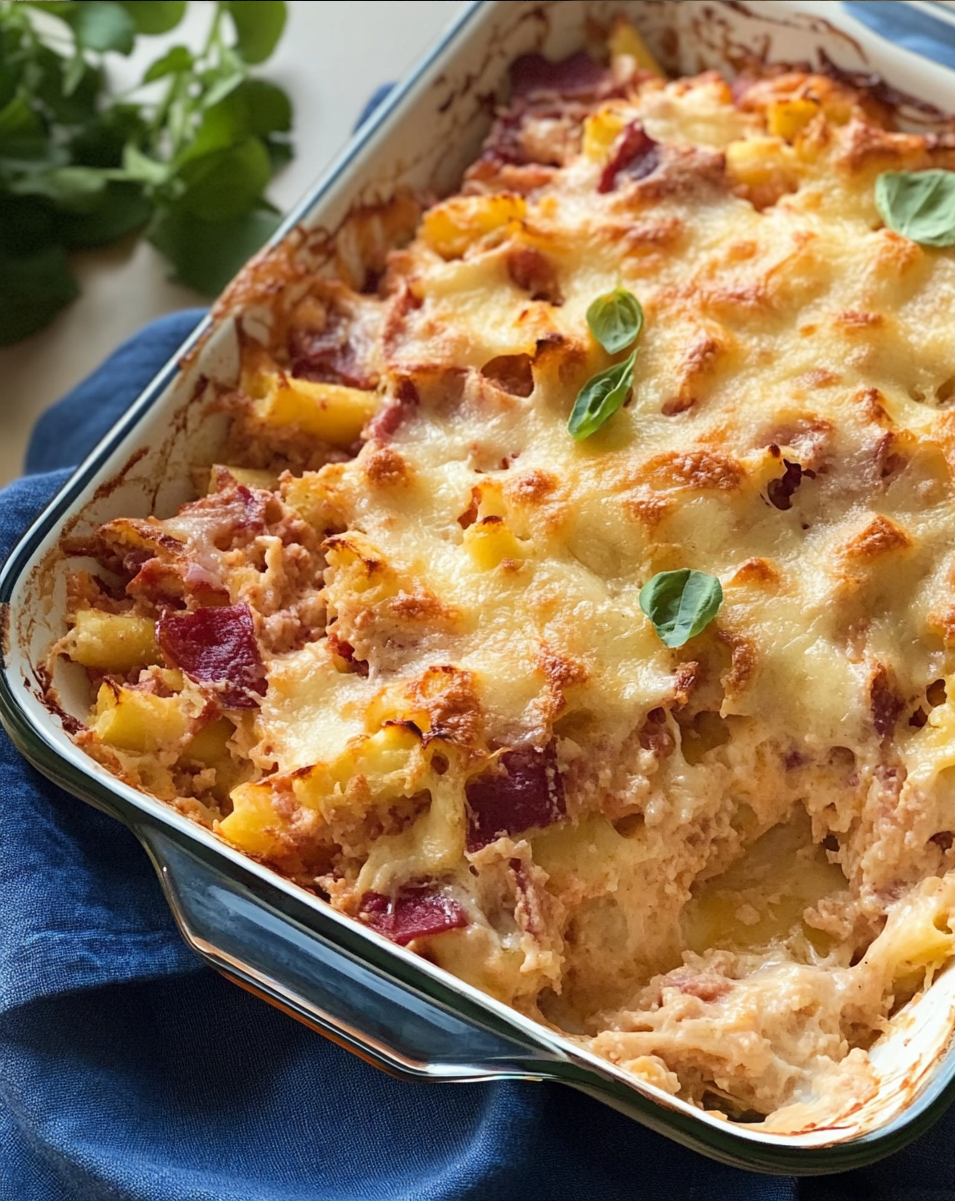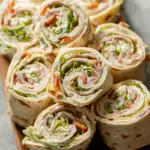This Reuben Casserole is a delightful twist on the classic sandwich, bringing all the beloved flavors of corned beef, sauerkraut, and Swiss cheese into a comforting, oven-baked dish. The rye bread cubes on top add a satisfying crunch, while the layers of meat and cheese meld together in a warm, gooey embrace that is sure to please any crowd.
Perfect for a cozy family dinner or a potluck gathering, this casserole is both easy to make and incredibly flavorful. The rich combination of corned beef, tangy sauerkraut, and creamy dressing, topped with golden, buttery bread cubes, makes this dish a true comfort food classic that everyone will love.
Full Recipe:
- 1 pound corned beef, sliced into strips
- 16 ounces sauerkraut, drained and squeezed dry
- 1 cup Thousand Island dressing
- 2 cups shredded Swiss cheese
- 6 slices rye bread, cubed
- 1/2 cup melted butter
Directions:
- Preheat oven to 350°F (175°C).
- Layer half of the corned beef in the bottom of a greased 9×13-inch baking dish.
- Spread the sauerkraut evenly over the corned beef.
- Drizzle the Thousand Island dressing over the sauerkraut layer.
- Sprinkle 1 cup of shredded Swiss cheese over the dressing.
- Top with the remaining corned beef, followed by the remaining 1 cup of Swiss cheese.
- In a bowl, toss the rye bread cubes with the melted butter until evenly coated.
- Spread the buttered rye bread cubes over the top of the casserole.
- Bake in the preheated oven for 30 minutes, or until the cheese is melted and the top is golden brown.
Prep Time: 15 minutes | Cooking Time: 30 minutes | Total Time: 45 minutes
Kcal: 520 kcal | Servings: 6 servings
History and Origins of the Reuben Casserole
The Reuben sandwich, a classic American favorite, is believed to have originated in the early 20th century, either in Omaha, Nebraska, or New York City, depending on which story you believe. The sandwich, traditionally made with corned beef, Swiss cheese, sauerkraut, and Russian or Thousand Island dressing on rye bread, has long been a staple in delis across the United States.
The Reuben Casserole is a creative adaptation of this beloved sandwich, transforming it from a handheld meal into a warm, comforting dish that’s perfect for family dinners or potluck gatherings. By layering the same key ingredients in a baking dish and topping it with buttery rye bread cubes, this casserole captures the essence of the sandwich while offering the ease and convenience of a baked dish.
Why You’ll Love This Recipe
1. Simple and Quick to Prepare: With just a few steps and less than an hour from start to finish, this Reuben Casserole is ideal for busy weeknights. The ingredients are easy to find, and the assembly is straightforward, making it a no-fuss meal that delivers big on flavor.
2. Classic Comfort Food: This casserole brings together all the comforting flavors of a Reuben sandwich in a warm, cheesy, and satisfying dish. The combination of savory corned beef, tangy sauerkraut, creamy dressing, and melted Swiss cheese is a surefire crowd-pleaser.
3. Versatile and Adaptable: You can easily adapt this recipe to suit your tastes or dietary preferences. For instance, you can substitute turkey or pastrami for the corned beef or use a different type of bread on top. If you’re looking to lighten it up, consider using reduced-fat cheese and dressing.
4. Perfect for Leftovers: This casserole makes for great leftovers. The flavors meld even more as they sit, making it a fantastic option for meal prep or for enjoying the next day.
Serving Suggestions
To round out the meal, consider serving this Reuben Casserole with a side of lightly dressed greens or a crisp dill pickle to cut through the richness of the dish. You could also pair it with a simple tomato soup or a potato salad for a more filling meal. If you’re serving it at a gathering, it pairs wonderfully with a variety of other appetizers like deviled eggs, or even a charcuterie board featuring different cheeses and cured meats.
Tips for Success
- Drain the Sauerkraut Well: To avoid a soggy casserole, be sure to drain and squeeze the sauerkraut thoroughly before layering it in the dish. Excess moisture can make the casserole too wet, so take your time with this step.
- Customize Your Cheese: While Swiss cheese is traditional, feel free to experiment with other types of cheese like Gruyère or a sharp cheddar if you want to switch up the flavors.
- Toast the Bread Cubes: For an extra crunch, consider toasting the rye bread cubes in a skillet before adding them to the casserole. This step ensures they stay crispy during baking.
Variations to Try
- Vegetarian Reuben Casserole: Replace the corned beef with a plant-based meat substitute or additional vegetables like mushrooms and bell peppers. You can also use a dairy-free cheese to make it vegan.
- Spicy Reuben Casserole: Add a kick to your casserole by mixing some horseradish or spicy mustard into the Thousand Island dressing or by adding a few slices of jalapeños.
- Low-Carb Reuben Casserole: Skip the bread and instead top the casserole with extra cheese, or use a low-carb bread alternative. You can also increase the amount of sauerkraut and corned beef for a heartier, low-carb dish.
Nutritional Insights
The Reuben Casserole is a hearty dish that offers a balance of protein, fat, and carbohydrates, making it a satisfying and filling meal. Here’s a closer look at the nutritional components:
- Protein: The corned beef and Swiss cheese in the casserole provide a good source of protein, essential for muscle repair and overall health. Protein is also key in making the dish satisfying and keeping you full longer.
- Fat: The casserole contains fats from the cheese, dressing, and buttered rye bread cubes. While these fats contribute to the richness of the dish, they also provide essential fatty acids that are important for brain function and hormone production.
- Carbohydrates: The rye bread cubes add a significant amount of carbohydrates, which are the body’s primary source of energy. Rye bread, in particular, offers complex carbs that digest more slowly, providing a steadier energy release.
- Fiber: The sauerkraut, made from fermented cabbage, is a good source of dietary fiber. Fiber is crucial for digestive health and helps maintain steady blood sugar levels.
- Probiotics: Sauerkraut is not only rich in fiber but also in probiotics due to the fermentation process. Probiotics support gut health by promoting a healthy balance of bacteria in the digestive system, which can boost immune function and improve digestion.
Ingredient Spotlight
Each ingredient in this Reuben Casserole plays a vital role in achieving the dish’s signature flavor and texture. Here’s a closer look at some of the key ingredients:
- Corned Beef: Corned beef is brisket that has been salt-cured, giving it a distinctive flavor that’s both salty and savory. It’s the heart of this dish, providing the robust, meaty flavor that makes the casserole so satisfying. Traditionally associated with Irish cuisine, corned beef became popular in American cooking, particularly around St. Patrick’s Day.
- Sauerkraut: Made from finely cut fermented cabbage, sauerkraut adds a tangy, slightly sour note that balances the richness of the meat and cheese. Its acidity cuts through the heavier ingredients, making the casserole more palatable and adding a layer of complexity to the flavor profile.
- Swiss Cheese: This cheese is known for its nutty, slightly sweet flavor and smooth, creamy texture. When melted in the casserole, Swiss cheese binds the layers together, adding a comforting creaminess to the dish.
- Thousand Island Dressing: This dressing is a combination of mayonnaise, ketchup, and other seasonings like pickles, onions, and sweet peppers. It’s creamy and tangy, which complements the sauerkraut and cheese, adding another layer of flavor. In the casserole, it acts as a binder and adds a slight sweetness that contrasts nicely with the salty corned beef and tart sauerkraut.
- Rye Bread: Rye bread, with its distinctive earthy flavor, is a traditional component of a Reuben sandwich. In this casserole, it’s cubed and buttered to create a crispy, flavorful topping that adds texture and depth to the dish.
Serving and Storage Tips
- Serving Suggestions: The Reuben Casserole is a meal in itself, but you can pair it with a few side dishes to round out your meal. A simple green salad with a light vinaigrette can balance the richness of the casserole. For a more traditional deli-style meal, serve it with a side of pickles or coleslaw. If you want to add a bit of freshness, a light tomato salad with onions and a drizzle of olive oil would be a great contrast to the hearty casserole.
- Leftovers: This casserole reheats beautifully, making it ideal for meal prep or enjoying over several days. Store any leftovers in an airtight container in the refrigerator for up to 3-4 days. To reheat, cover with foil and warm in a 350°F (175°C) oven until heated through. Alternatively, you can microwave individual portions, but be sure to do so in short intervals to avoid overcooking.
- Freezing: If you’d like to make the casserole ahead of time, it’s freezer-friendly! Assemble the casserole as directed, but don’t bake it. Instead, cover it tightly with plastic wrap and aluminum foil, then freeze for up to 2 months. When ready to enjoy, thaw it in the refrigerator overnight and bake as directed, adding a few extra minutes if necessary to ensure it’s heated through.
Cultural and Culinary Significance
The Reuben sandwich, and by extension the Reuben Casserole, holds a special place in American culinary history. It is often associated with Jewish delis, though its exact origin remains a subject of debate. Whether it was created by Reuben Kulakofsky in Omaha, Nebraska, or by Arnold Reuben in New York City, the sandwich became a staple in delis across the country.
The casserole version of the Reuben sandwich is an example of how traditional dishes can be reimagined for modern kitchens. Casseroles have long been a beloved dish in American homes, prized for their convenience, ability to feed a crowd, and the comfort they bring to the table. By transforming a classic sandwich into a casserole, home cooks can enjoy the flavors they love in a new, hearty format that’s perfect for family dinners or entertaining.
Interesting Facts
- National Reuben Day: Did you know that March 14th is National Reuben Day in the United States? It’s a day to celebrate the beloved sandwich and its many variations, including the Reuben Casserole.
- Health Considerations: While the traditional Reuben Casserole is rich and indulgent, you can make it lighter by using leaner cuts of corned beef, reduced-fat cheese, and a light dressing. Additionally, swapping out the rye bread for a whole-grain version can boost the fiber content.
- Culinary Variations: The Reuben Casserole has inspired many creative variations, including Reuben dips, which are a popular party appetizer, and even Reuben-inspired pizzas and pastas. These variations show how versatile the flavors of the classic sandwich can be.
Conclusion
The Reuben Casserole is more than just a dish—it’s a fusion of tradition, comfort, and convenience, bringing the classic flavors of a Reuben sandwich to the dinner table in a new and exciting way. Its rich history, tied to American culinary heritage, makes it a beloved recipe for many. Whether you’re serving it at a family gathering, a potluck, or enjoying it as a cozy meal at home, this casserole is sure to impress with its layers of corned beef, tangy sauerkraut, creamy dressing, and melted Swiss cheese topped with crispy rye bread.
Versatile and adaptable, the Reuben Casserole can be customized to suit different tastes and dietary needs, making it a go-to recipe for any occasion. Its ease of preparation, combined with the comforting, hearty flavors, ensures it will be a hit with anyone who tries it. So whether you’re looking to reinvent a classic or simply want to enjoy a warm, satisfying meal, the Reuben Casserole is a recipe you’ll want to keep in your repertoire.






